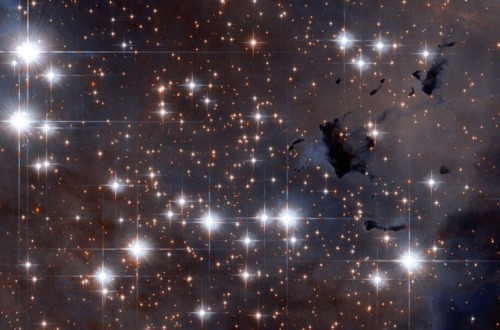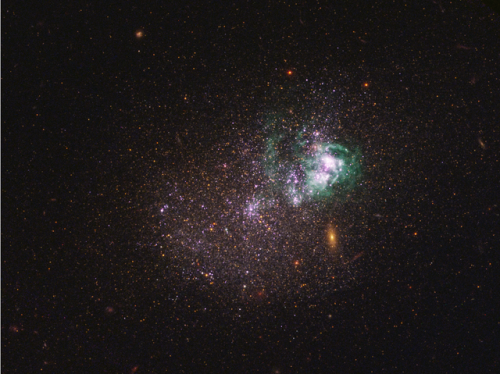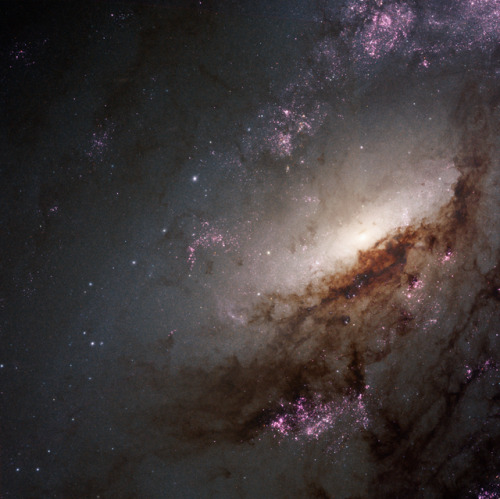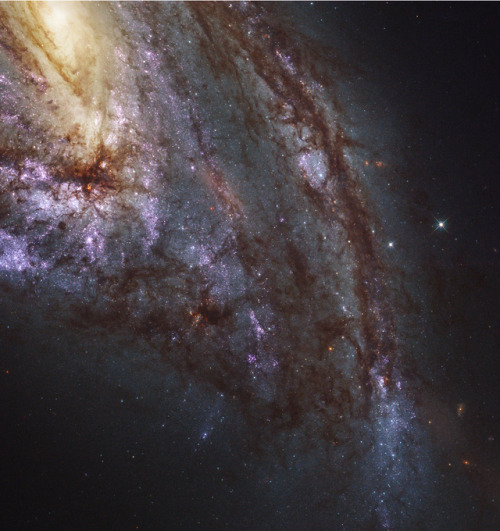Matthewjopdyke - Matthew J. Opdyke
More Posts from Matthewjopdyke and Others










Hubble Catches New Stars, Individually, Forming In Galaxies Beyond The Milky Way
“There are a massive variety of star-forming regions nearby, and Hubble’s new Legacy ExtraGalactic UV Survey (LEGUS) is now the sharpest, most comprehensive one ever. By imaging 50 nearby, star-forming spiral and dwarf galaxies, astronomers can see how the galactic environment affects star-formation.”
Within galaxies, new stars are going to be formed from the existing population of gas. But how that gas collapses and forms stars, as well as the types, numbers, and locations of the stars that will arise, is highly dependent on the galactic environment into which they are born. Dwarf galaxies, for example, tend to form stars when a nearby gravitational interaction triggers them. These bursts occur periodically, leading to multiple populations of stars of different ages. Spirals, on the other hand, form their new stars mostly along the lines traced by their arms, where the dust and gas is densest. Thanks to the Hubble Space Telescope, we’re capable of finding these stars and resolving them individually, using a combination of optical and ultraviolet data.
The best part? These are individually resolved stars from well outside our own galaxy: in 50 independent ones. Here’s what Hubble’s new LEGUS survey is revealing.

Curl up, read a new series of books, and be edified! Out now, Part 1, Vesha Celeste, and Part 2, Eliza Williams, have been paired together, and are available for those interested in the types and directions of science and the speculation that lead to well-being and quality of life. Please feel free to follow, message, share ideas, and be a part of a positive future where, if we choose, we can prepare properly to navigate the stars. This is just the beginning of this series and prequel, “Pathway to the Stars,” to an even more giant series, “Further than Before!” Please enjoy. https://www.amazon.com/author/matthewopdyke #sciencefiction #scifi #sciencefictionfantasy #scififantasy #politicalscifi #physiology #neurology #physics #Apolitical #strongfemalelead #biotechnology #neuroscience #theoreticalphysics #problemresolution #productivepursuits #spaceopera #cerebraldrama #sophisticateddialogue #solarsystem #spacemining #physiologicaloptimization, #neurologicaloptimization #transhumanism #universalethics #wellbeing #genetherapy #CRISPR #politicalsciencefiction #matthewopdyke https://www.instagram.com/p/BpUMW6ZgB1I/?utm_source=ig_tumblr_share&igshid=wy078mgrbgmm
Earth’s Ocean and Beyond

Image Credit: NOAA
Earth’s ocean has been the backdrop for ancient epics, tales of fictional fish and numerous scientific discoveries. It was, and will always be, a significant piece of the Earth’s story. Most of the ocean is unexplored– about 95% of this underwater realm is unseen by human eyes (NOAA). There is only one global Ocean. In fact, the ocean represents over 70% of the Earth’s surface and contains 96.5% of the Earth’s water.
We and the NOAA Office of Ocean Exploration and Research work together alongside organizations like the Schmidt Ocean Institute and Ocean Exploration Trust to better understand our oceans and its processes. While space may be the final frontier, understanding our own planet helps scientists as they explore space and study how our universe came to be.
On #WorldOceansDay let’s explore how Earth’s ocean informs our research throughout the solar system.
Earth and Exoplanets

“In interpreting what we see elsewhere in the solar system and universe, we always compare with phenomena that we already know of on Earth…We work from the familiar toward the unknown.” - Norman Kuring, NASA Goddard
We know of only one living planet: our own. As we move to the next stage in the search for alien life, the effort will require the expertise of scientists of all disciplines. However, the knowledge and tools NASA has developed to study life on Earth will also be one of the greatest assets to the quest.
The photo above shows what Earth would look like at a resolution of 3 pixels, the same that exoplanet-discovering missions would see. What should we look for, in the search of other planets like our own? What are the unmistakable signs of life, even if it comes in a form we don’t fully understand? Liquid water; every cell we know of – even bacteria around deep-sea vents that exist without sunlight – requires water.
Phytoplankton (Algae) Bloom vs. Atmosphere of Jupiter

Jupiter’s storms are mesmerizing in their beauty, captured in many gorgeous photos throughout the decades from missions like Voyager 1 and Juno. The ethereal swirls of Jupiter are the result of fluids in motion on a rotating body, which might come as a surprise, since its atmosphere is made of gas!
The eddies in Jupiter’s clouds appear very similar to those found in Earth’s ocean, like in the phytoplankton (or algae) bloom in the Baltic Sea, pictured above. The bloom was swept up in a vortex, just a part of how the ocean moves heat, carbon, and nutrients around the planet. Blooms like this, however, are not all beauty - they create “dead zones” in the areas where they grow, blooming and decaying at such a high rate that they consume all the oxygen in the water around them.
Arctic Sea Ice and Europa Ice Crust

While the Arctic (North Pole) and the Antarctic (South Pole) are “polar opposites,” there is one huge difference between the North and South Poles– land mass. The Arctic is ocean surrounded by land, while the Antarctic is land surrounded by ocean. The North Pole is located in the middle of the Arctic Ocean amid waters that are almost permanently covered with constantly shifting sea ice.
By studying this sea ice, scientists can research its impact on Earth system and even formation processes on other bodies like Europa, an icy moon of Jupiter. For example, it is possible that the reddish surface features on Europa’s ice may have communicated with a global subsurface ocean layer during or after their formation.
Aquanauts and Astronauts

As new missions are being developed, scientists are using Earth as a testbed. Just as prototypes for our Mars rovers made their trial runs on Earth’s deserts, researchers are testing both hypotheses and technology on our oceans and extreme environments.
NEEMO, our Extreme Environment Mission Operations project, is an analog mission that sends groups of astronauts, engineers and scientists to live in Aquarius, the world’s only undersea research station located off the Florida Keys, 62 feet (19 meters) below the surface. Much like space, the undersea world is a hostile, alien place for humans to live. NEEMO crew members, known as aquanauts, experience some of the same challenges there that they would on a distant asteroid, planet or moon.
Deep-sea Robotic Exploration and Space Robotic Exploration

Video credit: Deep Sea Robotics/Schmidt Ocean Institute and Mars Curiosity rover/NASA
From mapping the seafloor through bathymetry to collecting samples on the surface of Mars, researchers are utilizing new technologies more than ever to explore. Satellite and robotic technology allow us to explore where humans may not be able to– yet. They teach us valuable lessons about the extreme and changing environments, science, as well as provide a platform to test new technologies.
Jezero Crater and Dvina River Delta, Arkhangelsk, Russia/Mars Delta

River deltas, the point where a river meets the ocean, are sites of rich sediment and incredible biodiversity. The nutrients that rivers carry to the coastlines make a fertile place for fish and shellfish to lay their eggs.
The Jezero crater on Mars (pictured in false-color on the right) has been selected as the Mars2020 landing site, and has a structure that looks much like a river delta here on Earth! Pictures from our Mars Global Surveyor orbiter show eroded ancient deposits of transported sediment long since hardened into interweaving, curved ridges of layered rock. This is one of many hints that Mars was once covered in an ancient ocean that had more water than the Arctic Ocean. Studying these deltas on Earth helps us spot them on other planets, and learning about the ocean that was once on Mars informs how our own formed.
Make sure to follow us on Tumblr for your regular dose of space: http://nasa.tumblr.com.

You’re looking at a real big deal.
Because in a nanotechnology lab, big deals come in smaller and smaller packages. What you see above is an extreme close-up of a 5 nanometer transistor. In an industry-first, the IBM Research Alliance developed nanosheet transistors that will enable a 5 nm chip. What’s so big about that? Well, by achieving a scale of 30 billion switches on a fingernail sized chip, it can deliver significant enhancements over today’s state-of-the-art 10 nm chips. This not only improves the performance of current technologies but also provides the fuel for the future demands of AI, VR, quantum and mobile technologies to run on. Plus, it could also make things like smartphone batteries last 2-3x longer between charges, so it may also be a real lifesaver too.
Learn more about it->
10 Things: Journey to the Center of Mars
May the fifth be with you because history is about to be made: As early as May 5, 2018, we’re set to launch Mars InSight, the very first mission to study the deep interior of Mars. We’ve been roaming the surface of Mars for a while now, but when InSight lands on Nov. 26, 2018, we’re going in for a deeper look. Below, 10 things to know as we head to the heart of Mars.

Coverage of prelaunch and launch activities begins Thursday, May 3, on NASA Television and our homepage.
1. What’s in a name?

“Insight” is to see the inner nature of something, and the InSight lander—a.k.a. Interior Exploration using Seismic Investigations, Geodesy and Heat Transport—will do just that. InSight will take the “vital signs” of Mars: its pulse (seismology), temperature (heat flow) and reflexes (radio science). It will be the first thorough check-up since the planet formed 4.5 billion years ago.
2. Marsquakes.
You read that right: earthquakes, except on Mars. Scientists have seen a lot of evidence suggesting Mars has quakes, and InSight will try to detect marsquakes for the first time. By studying how seismic waves pass through the different layers of the planet (the crust, mantle and core), scientists can deduce the depths of these layers and what they’re made of. In this way, seismology is like taking an X-ray of the interior of Mars.
Want to know more? Check out this one-minute video.
3. More than Mars.

InSight is a Mars mission, but it’s also so much more than that. By studying the deep interior of Mars, we hope to learn how other rocky planets form. Earth and Mars were molded from the same primordial stuff more than 4.5 billion years ago, but then became quite different. Why didn’t they share the same fate? When it comes to rocky planets, we’ve only studied one in great detail: Earth. By comparing Earth’s interior to that of Mars, InSight’s team hopes to better understand our solar system. What they learn might even aid the search for Earth-like planets outside our solar system, narrowing down which ones might be able to support life.
4. Robot testing.
InSight looks a bit like an oversized crane game: When it lands on Mars this November, its robotic arm will be used to grasp and move objects on another planet for the first time. And like any crane game, practice makes it easier to capture the prize.
Want to see what a Mars robot test lab is like? Take a 360 tour.
5. The gang’s all here.

InSight will be traveling with a number of instruments, from cameras and antennas to the heat flow probe. Get up close and personal with each one in our instrument profiles.
6. Trifecta.

InSight has three major parts that make up the spacecraft: Cruise Stage; Entry, Descent, and Landing System; and the Lander. Find out what each one does here.
7. Solar wings.
Mars has weak sunlight because of its long distance from the Sun and a dusty, thin atmosphere. So InSight’s fan-like solar panels were specially designed to power InSight in this environment for at least one Martian year, or two Earth years.
8. Clues in the crust.

Our scientists have found evidence that Mars’ crust is not as dense as previously thought, a clue that could help researchers better understand the Red Planet’s interior structure and evolution. “The crust is the end-result of everything that happened during a planet’s history, so a lower density could have important implications about Mars’ formation and evolution,” said Sander Goossens of our Goddard Space Flight Center in Greenbelt, Maryland.
9. Passengers.

InSight won’t be flying solo—it will have two microchips on board inscribed with more than 2.4 million names submitted by the public. “It’s a fun way for the public to feel personally invested in the mission,” said Bruce Banerdt of our Jet Propulsion Laboratory, the mission’s principal investigator. “We’re happy to have them along for the ride.”
10. Tiny CubeSats, huge firsts.

The rocket that will loft InSight beyond Earth will also launch a separate NASA technology experiment: two mini-spacecraft called Mars Cube One, or MarCO. These suitcase-sized CubeSats will fly on their own path to Mars behindInSight. Their goal is to test new miniaturized deep space communication equipment and, if the MarCOs make it to Mars, may relay back InSight data as it enters the Martian atmosphere and lands. This will be a first test of miniaturized CubeSat technology at another planet, which researchers hope can offer new capabilities to future missions.
Check out the full version of ‘Solar System: 10 Thing to Know This Week’ HERE.
Make sure to follow us on Tumblr for your regular dose of space: http://nasa.tumblr.com.

NASAs SWIFT has made the largest ever ultraviolet image of the Andromeda Galaxy. The image shows a region 200,000 light-years wide and 100,000 light-years high
js


Please enjoy my new sci- fi fantasy novel as our heroes prepare for a giant space adventure in this two book series. Currently available on Amazon! Further than Before: Pathway to the Stars ( 2 book series) amazon.com/author/matthewopdyke #scififantasy #spaceopera #sciencefiction #mustread #scifinovels #fantasynovels #sciencefictionnovels #biotechnology #nanotechnology #theoreticalphysics #physics #darkmatter #utopian #strongfemalelead https://www.instagram.com/p/Bo1bqokgeJT/?utm_source=ig_tumblr_share&igshid=98bv21jpi1jt

Combined as one! Further than Before: Pathway to the Stars, Parts 1 & 2 in an 8.3 x 11.7 inch novel of 400K words that hit the intellect in the best and most sophisticated ways,... through #scifi #fantasy #mustread #physics #theoreticalphysics #spaceopera #strongfemalelead #strongmalerolemodel #physiology #neuroscience #nanotechnology #longevity #CRISPR and more! Enjoy! https://www.instagram.com/p/BsP4HEpn5eV/?utm_source=ig_tumblr_share&igshid=dntpo9632yjz

All three versions (chill, rock, orchestra) ***** Further than Before: Pathway to the Stars, Part 1 -- Audible ***** “Nature and humanity can be amazing, but likewise, it can be brutal. Brutality, as far too many know it, is unnecessary if we consider and implement one thing, innovation with purpose—a good purpose is brutality’s ideal replacement, and it comes minus unnecessary misery. It’s starting to become clear to me now what it is that we can do and how we can do it.” - Eliza Williams to Yesha Alevtina (Further than Before: Pathway to the Stars, Part 1) ***** #books #sciencefictionbooks #SpaceOpera #scifi #ftbpathwaypublications #grahambessellieu #matthewjopdyke #politicalsciencefiction https://www.instagram.com/p/BxGgatnAtas/?igshid=1r6xgyjrd88m6
